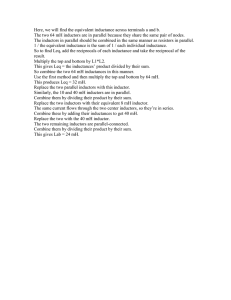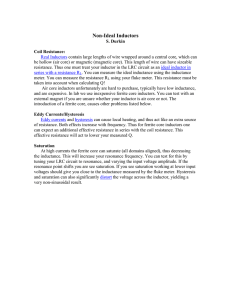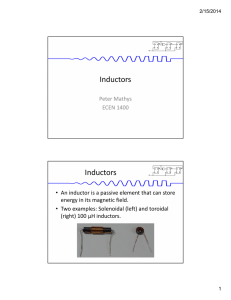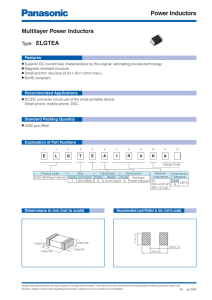Lecture 18
advertisement
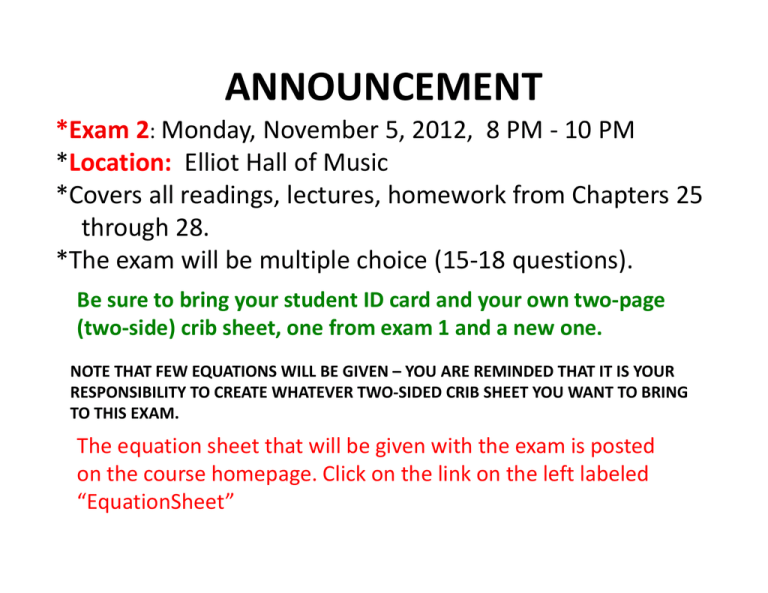
ANNOUNCEMENT *Exam 2: Monday, November 5, 2012, 8 PM - 10 PM *Location: Elliot Hall of Music *Covers all readings, lectures, homework from Chapters 25 through 28. *The exam will be multiple choice (15-18 questions). Be sure to bring your student ID card and your own two-page (two-side) crib sheet, one from exam 1 and a new one. NOTE THAT FEW EQUATIONS WILL BE GIVEN – YOU ARE REMINDED THAT IT IS YOUR RESPONSIBILITY TO CREATE WHATEVER TWO-SIDED CRIB SHEET YOU WANT TO BRING TO THIS EXAM. The equation sheet that will be given with the exam is posted on the course homepage. Click on the link on the left labeled “EquationSheet” ANNOUNCEMENT No lecture on Tuesday, November 20 (Week of Thanksgiving) Physics 24100 Electricity & Optics Lecture 15 – Chapter 28 sec. 6-9 Fall 2012 Semester Matthew Jones Clicker Question • An inductor in a circuit produces an induced EMF that is positive in the orientation shown: ℇ • Which statement could describe the current? (a) (b) (c) (d) (e) Increasing current to the right Decreasing current to the right Increasing current to the left Either (b) or (c) Either (a) or (c) Inductance • Magnetic field inside the solenoid: = • Magnetic flux: = = ℓ = ℓ • Flux is proportional to . • Inductance is = ℓ = ℓ Inductance vs Capacitance • = ℓ • Assume ≪ ℓ • only depends on geometry • Add a core of magnetic material: → • Stores energy in the magnetic field • = • Assume ≪ • only depends on geometry • Add a dielectric material: → • Stores energy in the electric field How Much Energy? • Energy density of a magnetic field: = 2 • Integrate this over a volume to calculate the total energy stored in the magnetic field. • Energy is conserved: – – – – A change in the magnetic field changes the energy density A changing magnetic field induces an electromotive force The EMF does work on charge carriers A reversible process How Much Energy? = 1.4 = 1.5" ℓ = 5" % # = $ = = 31'( 2 2 (10* kg moving at 90 km/h) Question • Suppose we modify a solenoid in various ways: 1. Double the length, ℓ 2. Double the radius, 3. Double the current, • Which statement about their inductances is true? (a) (b) (c) (d) > - > > > + > > + > - > + + Question • • • • For a solenoid, = ℓ Doubling ℓ will double the inductance Doubling will quadruple the inductance Doubling does not change the inductance – It would double but not Which statement about their inductances is true? (a) + > > (b) - > > + (c) ./ > .0 > .1 (d) > -> + Inductors in Circuits The voltage induced across the inductor opposes any change in current. ℇ − 3 − 4 =0 Inductors in Circuits 5 56789 ℇ − 3 − ℇ = 3 + 4 =0 4 > : − : ;<= = " 4 > : = ?> + " 4 The mechanical analog of inductance is mass. The inertia associated with a mass resists changes in velocity. The inductance resists changes in current. + Inductors in Circuits − A D . ∆$ • At time 4 = 0 the switch is closed an current will start to flow. • Initially, the inductor produces a potential difference equal to A which opposes the flow of current. • When the current reaches the steady state B = A/D, the inductor acts like a wire, with no potential difference. Inductors in Circuits D + A . − • Kirchhoff’s loop rule: F G $ = 3 + ∆$ I(4) = 0.632 • A solution is 4 H = I 1 − J KG/L where M = ./D 4 = /3 + Inductors in Circuits A − D . • What is the potential difference across the inductor? • Kirchhoff’s loop rule: Δ$ = 0.368$ $ − 3 − Δ$ = 0 Δ$ = $J KG/L ∆$ Δ$(4) 4 = /3 Inductors in Circuits D + . A ∆$ − • Initial current is • Switched at 4 = 0 • The inductor tries to keep the current flowing: 4 = J KG/L (4) The current can still flow after the switch is flipped but now the voltage source isn’t adding energy to the circuit. = 0.368 4 = /3 Inductors in Circuits + D A . ∆$ − • What is the potential difference across the inductor after the switch is opened? Δ$ = 0.632$ Δ$(4) Δ$ 4 = $ 1 − J KG/L 4 = /3 Inductors in Series • Putting two solenoids in series is like adding ℓ their lengths: = .0 + TU;VUT = .WX7YXW ./ + = + = (ℓ+ + ℓ ) Inductors in series add (just like resistors) Inductors in Parallel • Use Kirchhoff’s node rule: B .0 ./ ∥ B0 + 4 1 ∥ 4 + ∥ 4 1 + ∥ 4 + 4 + 4 = 4 B/ ∥ = = 4 = + = 1 + + 1 4 = 1 + + 1 K+ Mutual Inductance • What if we had two loops? • In this case the flux through coil 2 is proportional to the current through coil 1. ∝ + = '+ + • '+ is called the “mutual inductance” Mutual Inductance • Induced EMF from Faraday’s Law… ℇ =− 4 = −'+ + 4 • Important applications: Transformers – More on this later… Superconductors • Below a critical temperature, \ , a superconductor has zero resistance. • A “Type I” superconductor is a perfect diamagnetic material: ] = −1 • When it is brought into a magnetic field, the induced current create an equal and opposite magnetic field = <^^ 1 + ] = 0 Superconductors Magnet: NdFeB Superconductor: YBa2Cu3O7 Question • In which circuit will the light stay lit the longest when the circuit is switched at 4 = 0?
